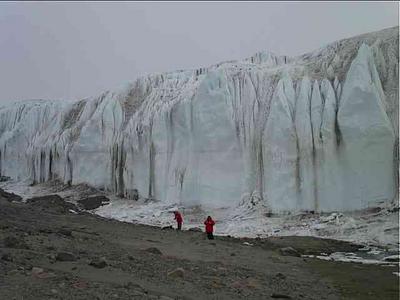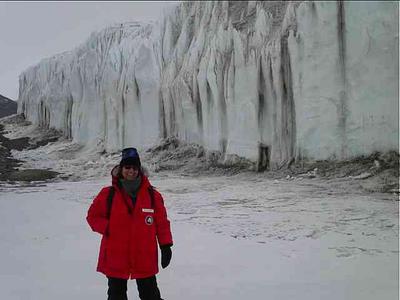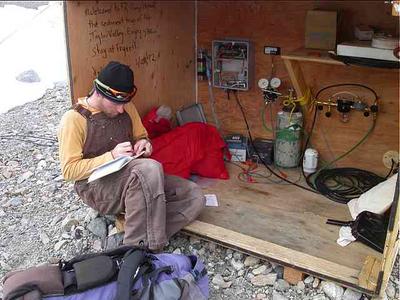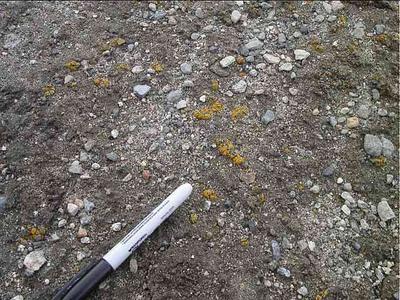28 December, 2002
Introduction to Stream Science
This journal actually takes place on Dec. 27th (which is your Dec.
26th). Somehow I got ahead a day on my journals. I'm so confused : )
We had a slow morning because we heard that Santa Claus was arriving
by helicopter to bring us some goodies. We cleaned everything up and
made it nice and tidy. Sure enough Santa and his helpers arrived in
good cheer. We had a nice visit, although they told us our treats had
been left at Lake Hoare where we are going on Saturday. Bummer - hope
they are still there when we get there!
After lunch Karen and Pete took off in one direction to get their
bearings and to have Pete check some gages in the relic channel.
John, Jen and I walked out onto the lake ice and started up the snow
mobile. We were headed out to visit all of the streams on Lake
Fryxell.
The lake ice is really interesting. There is a liquid moat of melted
ice around the shore that you have to step over or walk through.
Luckily, it is not too wide yet, and we did not have to get our feet
wet. You also have to be careful because there are spots where the
ice near shore is melting and will break under your weight. It is
kind of scary too, because in patches it is really slick ice - you
can actually ice skate in your boots! It is also a little unnerving
because the ice is so clear that sometimes you feel you can see the
water underneath. In other places it is heaved up and rough, and I
was afraid I might twist my ankle. I have never seen so many
different kinds of ice in such a small area.
We climbed onto the snow mobile - with ME in the driver's seat, John
behind me, and Jen riding the sled. The sled was a riot! Sometimes
Jen would speed up and pass us! Once in awhile the skis under me
would skid and then the sled would pull us more off kilter. My Mario
Andretti driving skills got us back under control, and then I just
had to make sure not to hit the pressure ridges of the old ice in the
center of the lake, or the thin, melting ice near the moat.
John worked at the gage boxes for the streams that feed Lake Fryxell.
The box is a large wooden structure housing a few small instruments.
It is intentionally big enough for a person to climb into for
shelter, in case a scientist should get caught outside during a
katabatic event. Katabatics are the winds that sweep down off the
polar plateau and roar through the valleys with winds of 75 MPH or
more.
Jen and I got our bearings and found some of the surveying markers
that we will soon need. John took conductivity, temperature and pH
readings in each of the streams. Conductivity is the total ions in
solution. The pH probe gave us some trouble as it was giving readings
that did not seem to be accurate. We plan to re-calibrate it back in
the lab at F6 before taking those readings again.
As John said, this is truly an ecosystem on the edge. We have had
just a day and a half of clouds and that little change in temperature
has made several of the streams stop flowing. Most of the ones we
visited today were just trickles, even though some had been flowing
just a few days ago. The algae must be extremely hardy souls to
withstand the starts and stops of water during their growing season.
We hiked up the slopes to the transects which have been built across
the streams. It was important to watch where we walked. There were
some algae and mosses growing along the stream beds. They live in
such a harsh environment, with such an incredibly short growing
season, that it is essential not to step on them.

1.
John and Jen in front of Canada Glacier. Check out the scale!

2.
Me in front of the Canada Glacier - my first glacier!

3.
John recording observations sitting in the stream gage box.

4.
This one is for you Mary Slack! You wanted to know what a transect
looks like - does this help?

5.Yellow algae - life in the Dry Valleys

6.
Me driving snow mobile - there are some real perks to science field
work!

7. Jen riding the sled with all our equipment for
sampling.
Contact the TEA in the field at
.
If you cannot connect through your browser, copy the
TEA's e-mail address in the "To:" line of
your favorite e-mail package.
|
